Report on Sources of Funds and Entity Classification Analysis
VerifiedAdded on 2021/02/22
|18
|4975
|70
Report
AI Summary
This report provides a comprehensive analysis of the sources of funds and the classification of entities for financial reporting purposes. It examines the financial statements of two ASX-listed companies in the financial services sector, National Australian Bank (NAB) and Macquarie Group Limited (MQG), over a three-year period. The report identifies and discusses various sources of funds, including equity and debt financing, and analyzes the movements in key balance sheet items, such as owners' equity and liabilities. It highlights the growth in total liabilities and owners' equity for both companies, with specific figures and justifications for the observed trends. Furthermore, the report delves into the classification of different types of companies and their associated compliance and reporting requirements under the Corporations Act 2001, emphasizing the potential consequences of non-compliance. The analysis includes detailed examination of items recorded on the balance sheet under owners' equity and liabilities sections for both companies and assesses their movements over the specified period. It also provides insights into the reasons behind these movements, such as changes in contributed equity, reserves, retained earnings, and non-controlling interests for both NAB and MQG. The report concludes by emphasizing the significance of understanding these concepts for effective financial management and regulatory compliance.
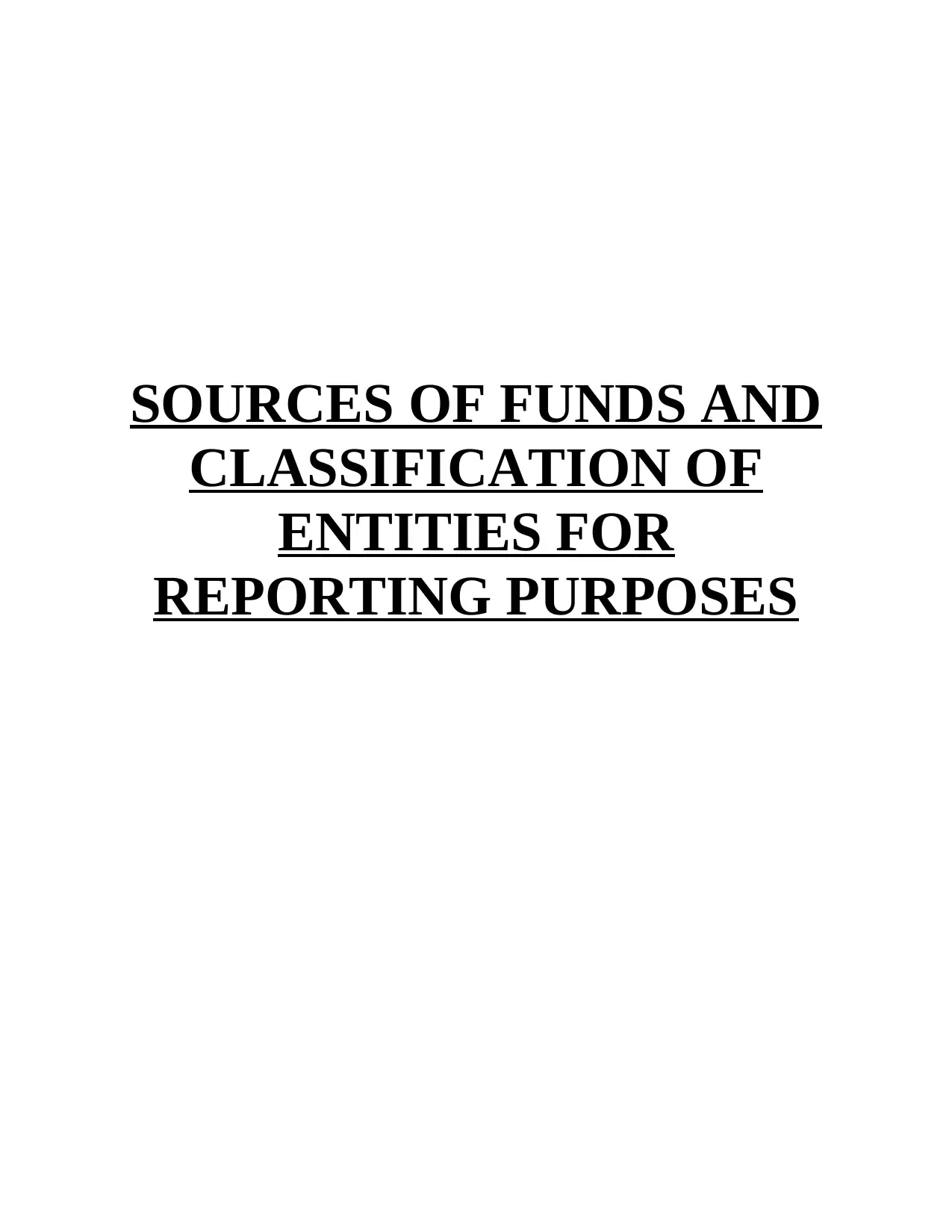
SOURCES OF FUNDS AND
CLASSIFICATION OF
ENTITIES FOR
REPORTING PURPOSES
CLASSIFICATION OF
ENTITIES FOR
REPORTING PURPOSES
Paraphrase This Document
Need a fresh take? Get an instant paraphrase of this document with our AI Paraphraser
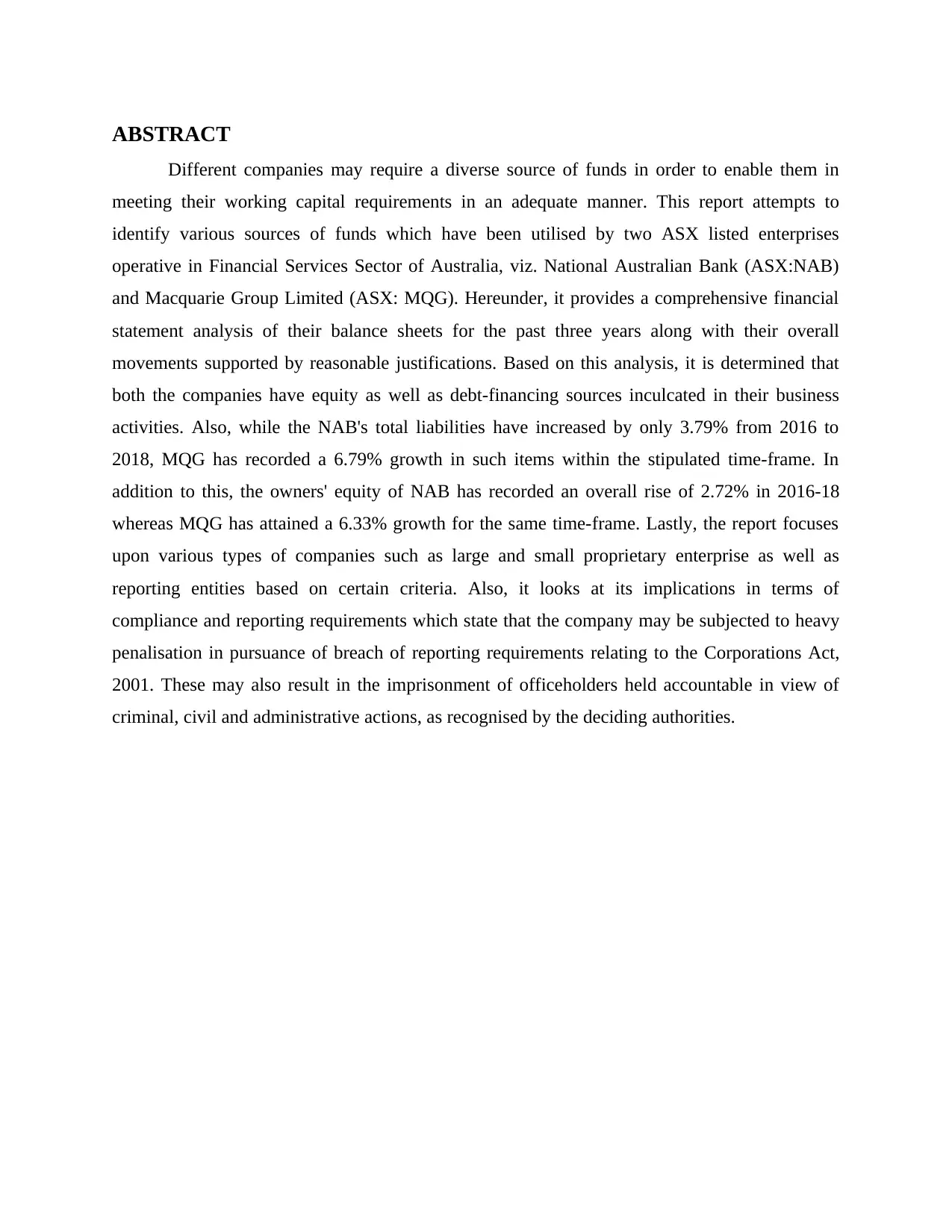
ABSTRACT
Different companies may require a diverse source of funds in order to enable them in
meeting their working capital requirements in an adequate manner. This report attempts to
identify various sources of funds which have been utilised by two ASX listed enterprises
operative in Financial Services Sector of Australia, viz. National Australian Bank (ASX:NAB)
and Macquarie Group Limited (ASX: MQG). Hereunder, it provides a comprehensive financial
statement analysis of their balance sheets for the past three years along with their overall
movements supported by reasonable justifications. Based on this analysis, it is determined that
both the companies have equity as well as debt-financing sources inculcated in their business
activities. Also, while the NAB's total liabilities have increased by only 3.79% from 2016 to
2018, MQG has recorded a 6.79% growth in such items within the stipulated time-frame. In
addition to this, the owners' equity of NAB has recorded an overall rise of 2.72% in 2016-18
whereas MQG has attained a 6.33% growth for the same time-frame. Lastly, the report focuses
upon various types of companies such as large and small proprietary enterprise as well as
reporting entities based on certain criteria. Also, it looks at its implications in terms of
compliance and reporting requirements which state that the company may be subjected to heavy
penalisation in pursuance of breach of reporting requirements relating to the Corporations Act,
2001. These may also result in the imprisonment of officeholders held accountable in view of
criminal, civil and administrative actions, as recognised by the deciding authorities.
Different companies may require a diverse source of funds in order to enable them in
meeting their working capital requirements in an adequate manner. This report attempts to
identify various sources of funds which have been utilised by two ASX listed enterprises
operative in Financial Services Sector of Australia, viz. National Australian Bank (ASX:NAB)
and Macquarie Group Limited (ASX: MQG). Hereunder, it provides a comprehensive financial
statement analysis of their balance sheets for the past three years along with their overall
movements supported by reasonable justifications. Based on this analysis, it is determined that
both the companies have equity as well as debt-financing sources inculcated in their business
activities. Also, while the NAB's total liabilities have increased by only 3.79% from 2016 to
2018, MQG has recorded a 6.79% growth in such items within the stipulated time-frame. In
addition to this, the owners' equity of NAB has recorded an overall rise of 2.72% in 2016-18
whereas MQG has attained a 6.33% growth for the same time-frame. Lastly, the report focuses
upon various types of companies such as large and small proprietary enterprise as well as
reporting entities based on certain criteria. Also, it looks at its implications in terms of
compliance and reporting requirements which state that the company may be subjected to heavy
penalisation in pursuance of breach of reporting requirements relating to the Corporations Act,
2001. These may also result in the imprisonment of officeholders held accountable in view of
criminal, civil and administrative actions, as recognised by the deciding authorities.
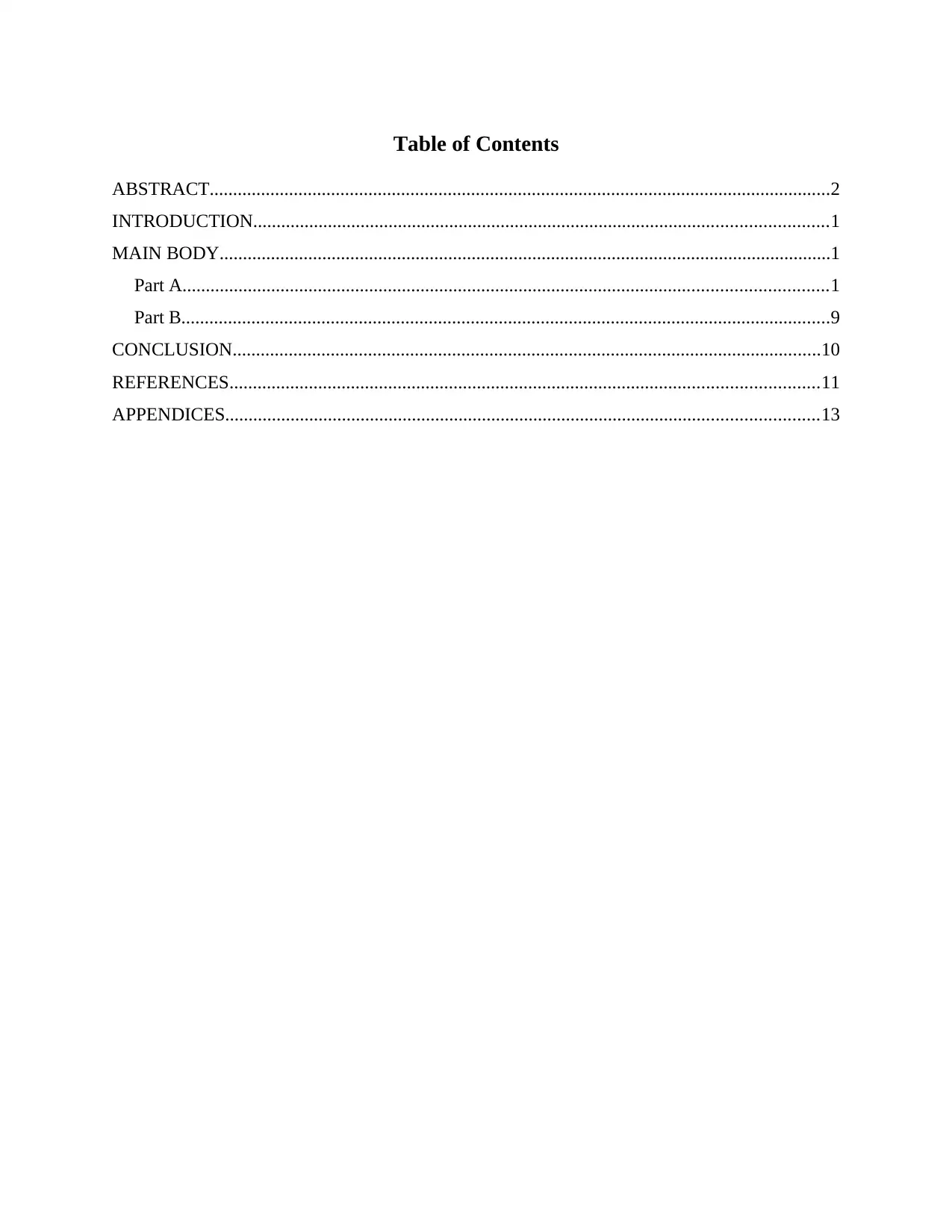
Table of Contents
ABSTRACT.....................................................................................................................................2
INTRODUCTION...........................................................................................................................1
MAIN BODY...................................................................................................................................1
Part A..........................................................................................................................................1
Part B...........................................................................................................................................9
CONCLUSION..............................................................................................................................10
REFERENCES..............................................................................................................................11
APPENDICES...............................................................................................................................13
ABSTRACT.....................................................................................................................................2
INTRODUCTION...........................................................................................................................1
MAIN BODY...................................................................................................................................1
Part A..........................................................................................................................................1
Part B...........................................................................................................................................9
CONCLUSION..............................................................................................................................10
REFERENCES..............................................................................................................................11
APPENDICES...............................................................................................................................13
⊘ This is a preview!⊘
Do you want full access?
Subscribe today to unlock all pages.

Trusted by 1+ million students worldwide

Paraphrase This Document
Need a fresh take? Get an instant paraphrase of this document with our AI Paraphraser
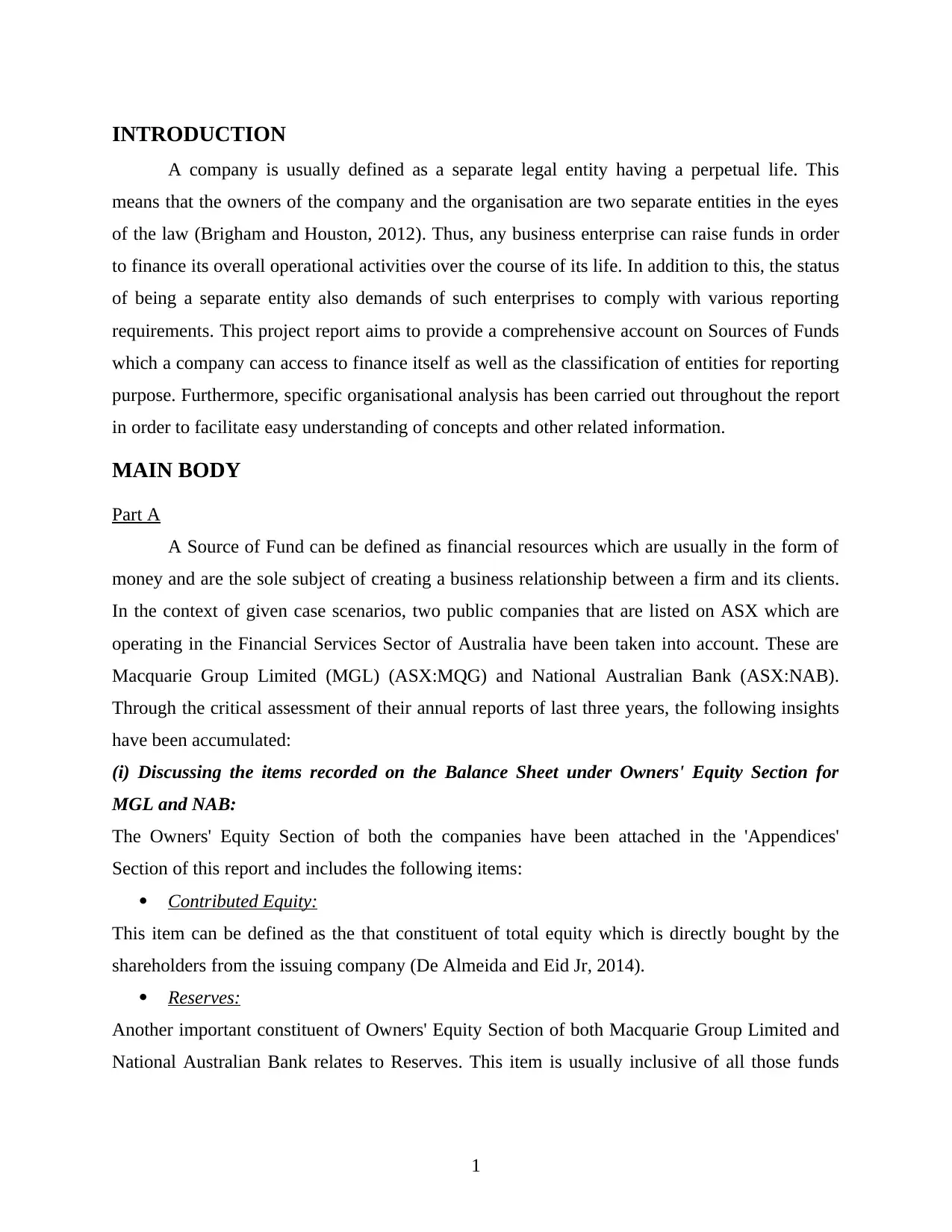
INTRODUCTION
A company is usually defined as a separate legal entity having a perpetual life. This
means that the owners of the company and the organisation are two separate entities in the eyes
of the law (Brigham and Houston, 2012). Thus, any business enterprise can raise funds in order
to finance its overall operational activities over the course of its life. In addition to this, the status
of being a separate entity also demands of such enterprises to comply with various reporting
requirements. This project report aims to provide a comprehensive account on Sources of Funds
which a company can access to finance itself as well as the classification of entities for reporting
purpose. Furthermore, specific organisational analysis has been carried out throughout the report
in order to facilitate easy understanding of concepts and other related information.
MAIN BODY
Part A
A Source of Fund can be defined as financial resources which are usually in the form of
money and are the sole subject of creating a business relationship between a firm and its clients.
In the context of given case scenarios, two public companies that are listed on ASX which are
operating in the Financial Services Sector of Australia have been taken into account. These are
Macquarie Group Limited (MGL) (ASX:MQG) and National Australian Bank (ASX:NAB).
Through the critical assessment of their annual reports of last three years, the following insights
have been accumulated:
(i) Discussing the items recorded on the Balance Sheet under Owners' Equity Section for
MGL and NAB:
The Owners' Equity Section of both the companies have been attached in the 'Appendices'
Section of this report and includes the following items:
Contributed Equity:
This item can be defined as the that constituent of total equity which is directly bought by the
shareholders from the issuing company (De Almeida and Eid Jr, 2014).
Reserves:
Another important constituent of Owners' Equity Section of both Macquarie Group Limited and
National Australian Bank relates to Reserves. This item is usually inclusive of all those funds
1
A company is usually defined as a separate legal entity having a perpetual life. This
means that the owners of the company and the organisation are two separate entities in the eyes
of the law (Brigham and Houston, 2012). Thus, any business enterprise can raise funds in order
to finance its overall operational activities over the course of its life. In addition to this, the status
of being a separate entity also demands of such enterprises to comply with various reporting
requirements. This project report aims to provide a comprehensive account on Sources of Funds
which a company can access to finance itself as well as the classification of entities for reporting
purpose. Furthermore, specific organisational analysis has been carried out throughout the report
in order to facilitate easy understanding of concepts and other related information.
MAIN BODY
Part A
A Source of Fund can be defined as financial resources which are usually in the form of
money and are the sole subject of creating a business relationship between a firm and its clients.
In the context of given case scenarios, two public companies that are listed on ASX which are
operating in the Financial Services Sector of Australia have been taken into account. These are
Macquarie Group Limited (MGL) (ASX:MQG) and National Australian Bank (ASX:NAB).
Through the critical assessment of their annual reports of last three years, the following insights
have been accumulated:
(i) Discussing the items recorded on the Balance Sheet under Owners' Equity Section for
MGL and NAB:
The Owners' Equity Section of both the companies have been attached in the 'Appendices'
Section of this report and includes the following items:
Contributed Equity:
This item can be defined as the that constituent of total equity which is directly bought by the
shareholders from the issuing company (De Almeida and Eid Jr, 2014).
Reserves:
Another important constituent of Owners' Equity Section of both Macquarie Group Limited and
National Australian Bank relates to Reserves. This item is usually inclusive of all those funds
1
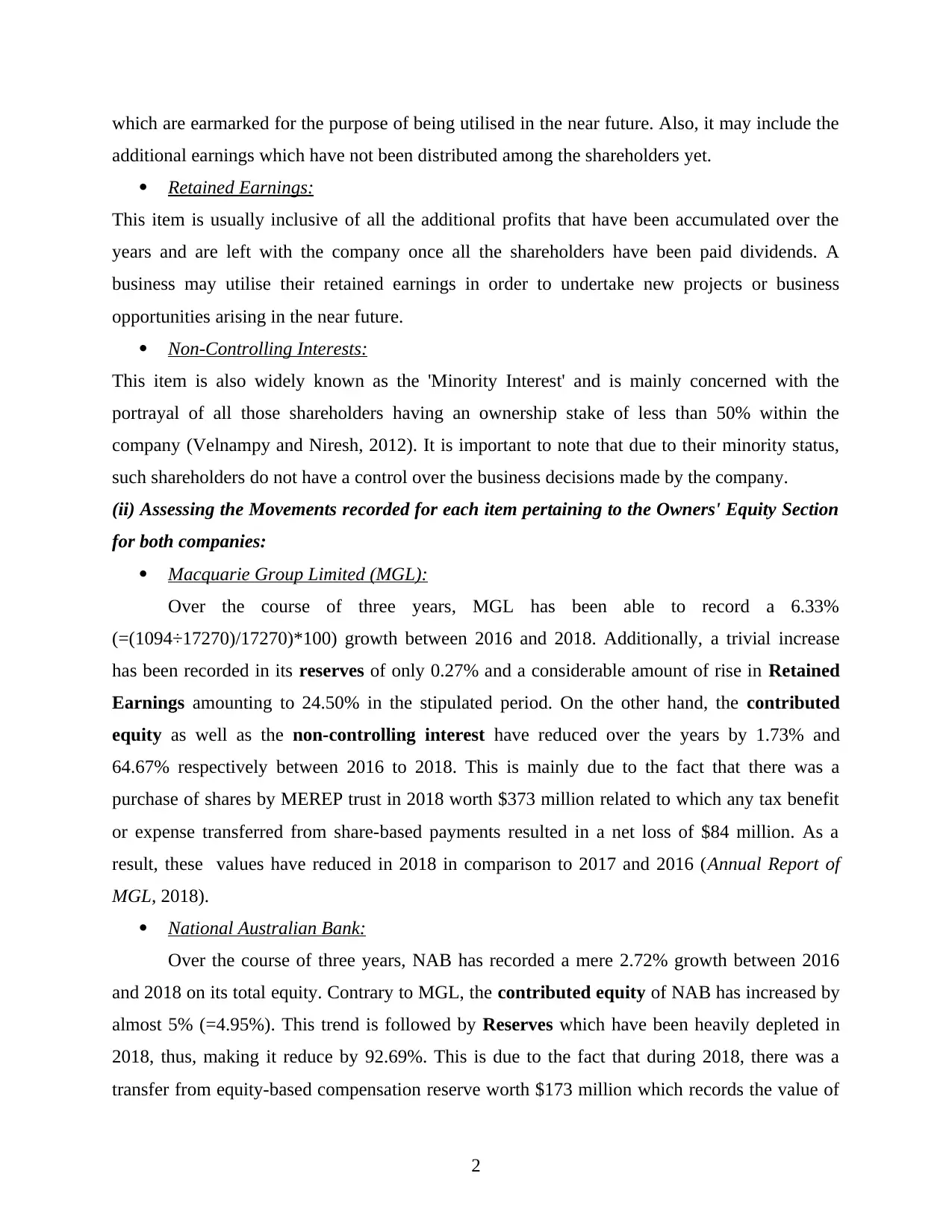
which are earmarked for the purpose of being utilised in the near future. Also, it may include the
additional earnings which have not been distributed among the shareholders yet.
Retained Earnings:
This item is usually inclusive of all the additional profits that have been accumulated over the
years and are left with the company once all the shareholders have been paid dividends. A
business may utilise their retained earnings in order to undertake new projects or business
opportunities arising in the near future.
Non-Controlling Interests:
This item is also widely known as the 'Minority Interest' and is mainly concerned with the
portrayal of all those shareholders having an ownership stake of less than 50% within the
company (Velnampy and Niresh, 2012). It is important to note that due to their minority status,
such shareholders do not have a control over the business decisions made by the company.
(ii) Assessing the Movements recorded for each item pertaining to the Owners' Equity Section
for both companies:
Macquarie Group Limited (MGL):
Over the course of three years, MGL has been able to record a 6.33%
(=(1094÷17270)/17270)*100) growth between 2016 and 2018. Additionally, a trivial increase
has been recorded in its reserves of only 0.27% and a considerable amount of rise in Retained
Earnings amounting to 24.50% in the stipulated period. On the other hand, the contributed
equity as well as the non-controlling interest have reduced over the years by 1.73% and
64.67% respectively between 2016 to 2018. This is mainly due to the fact that there was a
purchase of shares by MEREP trust in 2018 worth $373 million related to which any tax benefit
or expense transferred from share-based payments resulted in a net loss of $84 million. As a
result, these values have reduced in 2018 in comparison to 2017 and 2016 (Annual Report of
MGL, 2018).
National Australian Bank:
Over the course of three years, NAB has recorded a mere 2.72% growth between 2016
and 2018 on its total equity. Contrary to MGL, the contributed equity of NAB has increased by
almost 5% (=4.95%). This trend is followed by Reserves which have been heavily depleted in
2018, thus, making it reduce by 92.69%. This is due to the fact that during 2018, there was a
transfer from equity-based compensation reserve worth $173 million which records the value of
2
additional earnings which have not been distributed among the shareholders yet.
Retained Earnings:
This item is usually inclusive of all the additional profits that have been accumulated over the
years and are left with the company once all the shareholders have been paid dividends. A
business may utilise their retained earnings in order to undertake new projects or business
opportunities arising in the near future.
Non-Controlling Interests:
This item is also widely known as the 'Minority Interest' and is mainly concerned with the
portrayal of all those shareholders having an ownership stake of less than 50% within the
company (Velnampy and Niresh, 2012). It is important to note that due to their minority status,
such shareholders do not have a control over the business decisions made by the company.
(ii) Assessing the Movements recorded for each item pertaining to the Owners' Equity Section
for both companies:
Macquarie Group Limited (MGL):
Over the course of three years, MGL has been able to record a 6.33%
(=(1094÷17270)/17270)*100) growth between 2016 and 2018. Additionally, a trivial increase
has been recorded in its reserves of only 0.27% and a considerable amount of rise in Retained
Earnings amounting to 24.50% in the stipulated period. On the other hand, the contributed
equity as well as the non-controlling interest have reduced over the years by 1.73% and
64.67% respectively between 2016 to 2018. This is mainly due to the fact that there was a
purchase of shares by MEREP trust in 2018 worth $373 million related to which any tax benefit
or expense transferred from share-based payments resulted in a net loss of $84 million. As a
result, these values have reduced in 2018 in comparison to 2017 and 2016 (Annual Report of
MGL, 2018).
National Australian Bank:
Over the course of three years, NAB has recorded a mere 2.72% growth between 2016
and 2018 on its total equity. Contrary to MGL, the contributed equity of NAB has increased by
almost 5% (=4.95%). This trend is followed by Reserves which have been heavily depleted in
2018, thus, making it reduce by 92.69%. This is due to the fact that during 2018, there was a
transfer from equity-based compensation reserve worth $173 million which records the value of
2
⊘ This is a preview!⊘
Do you want full access?
Subscribe today to unlock all pages.

Trusted by 1+ million students worldwide
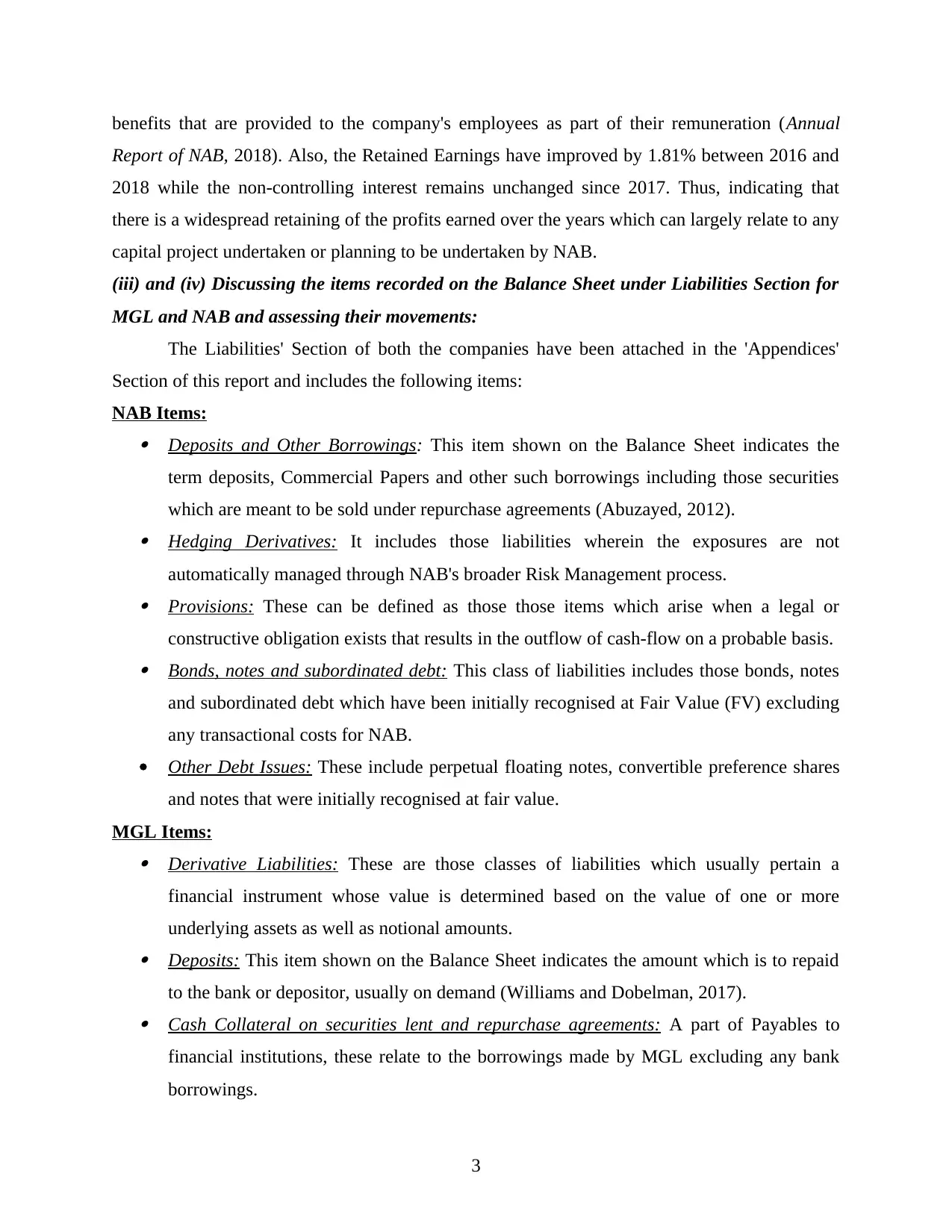
benefits that are provided to the company's employees as part of their remuneration (Annual
Report of NAB, 2018). Also, the Retained Earnings have improved by 1.81% between 2016 and
2018 while the non-controlling interest remains unchanged since 2017. Thus, indicating that
there is a widespread retaining of the profits earned over the years which can largely relate to any
capital project undertaken or planning to be undertaken by NAB.
(iii) and (iv) Discussing the items recorded on the Balance Sheet under Liabilities Section for
MGL and NAB and assessing their movements:
The Liabilities' Section of both the companies have been attached in the 'Appendices'
Section of this report and includes the following items:
NAB Items: Deposits and Other Borrowings: This item shown on the Balance Sheet indicates the
term deposits, Commercial Papers and other such borrowings including those securities
which are meant to be sold under repurchase agreements (Abuzayed, 2012). Hedging Derivatives: It includes those liabilities wherein the exposures are not
automatically managed through NAB's broader Risk Management process. Provisions: These can be defined as those those items which arise when a legal or
constructive obligation exists that results in the outflow of cash-flow on a probable basis. Bonds, notes and subordinated debt: This class of liabilities includes those bonds, notes
and subordinated debt which have been initially recognised at Fair Value (FV) excluding
any transactional costs for NAB.
Other Debt Issues: These include perpetual floating notes, convertible preference shares
and notes that were initially recognised at fair value.
MGL Items: Derivative Liabilities: These are those classes of liabilities which usually pertain a
financial instrument whose value is determined based on the value of one or more
underlying assets as well as notional amounts. Deposits: This item shown on the Balance Sheet indicates the amount which is to repaid
to the bank or depositor, usually on demand (Williams and Dobelman, 2017). Cash Collateral on securities lent and repurchase agreements: A part of Payables to
financial institutions, these relate to the borrowings made by MGL excluding any bank
borrowings.
3
Report of NAB, 2018). Also, the Retained Earnings have improved by 1.81% between 2016 and
2018 while the non-controlling interest remains unchanged since 2017. Thus, indicating that
there is a widespread retaining of the profits earned over the years which can largely relate to any
capital project undertaken or planning to be undertaken by NAB.
(iii) and (iv) Discussing the items recorded on the Balance Sheet under Liabilities Section for
MGL and NAB and assessing their movements:
The Liabilities' Section of both the companies have been attached in the 'Appendices'
Section of this report and includes the following items:
NAB Items: Deposits and Other Borrowings: This item shown on the Balance Sheet indicates the
term deposits, Commercial Papers and other such borrowings including those securities
which are meant to be sold under repurchase agreements (Abuzayed, 2012). Hedging Derivatives: It includes those liabilities wherein the exposures are not
automatically managed through NAB's broader Risk Management process. Provisions: These can be defined as those those items which arise when a legal or
constructive obligation exists that results in the outflow of cash-flow on a probable basis. Bonds, notes and subordinated debt: This class of liabilities includes those bonds, notes
and subordinated debt which have been initially recognised at Fair Value (FV) excluding
any transactional costs for NAB.
Other Debt Issues: These include perpetual floating notes, convertible preference shares
and notes that were initially recognised at fair value.
MGL Items: Derivative Liabilities: These are those classes of liabilities which usually pertain a
financial instrument whose value is determined based on the value of one or more
underlying assets as well as notional amounts. Deposits: This item shown on the Balance Sheet indicates the amount which is to repaid
to the bank or depositor, usually on demand (Williams and Dobelman, 2017). Cash Collateral on securities lent and repurchase agreements: A part of Payables to
financial institutions, these relate to the borrowings made by MGL excluding any bank
borrowings.
3
Paraphrase This Document
Need a fresh take? Get an instant paraphrase of this document with our AI Paraphraser
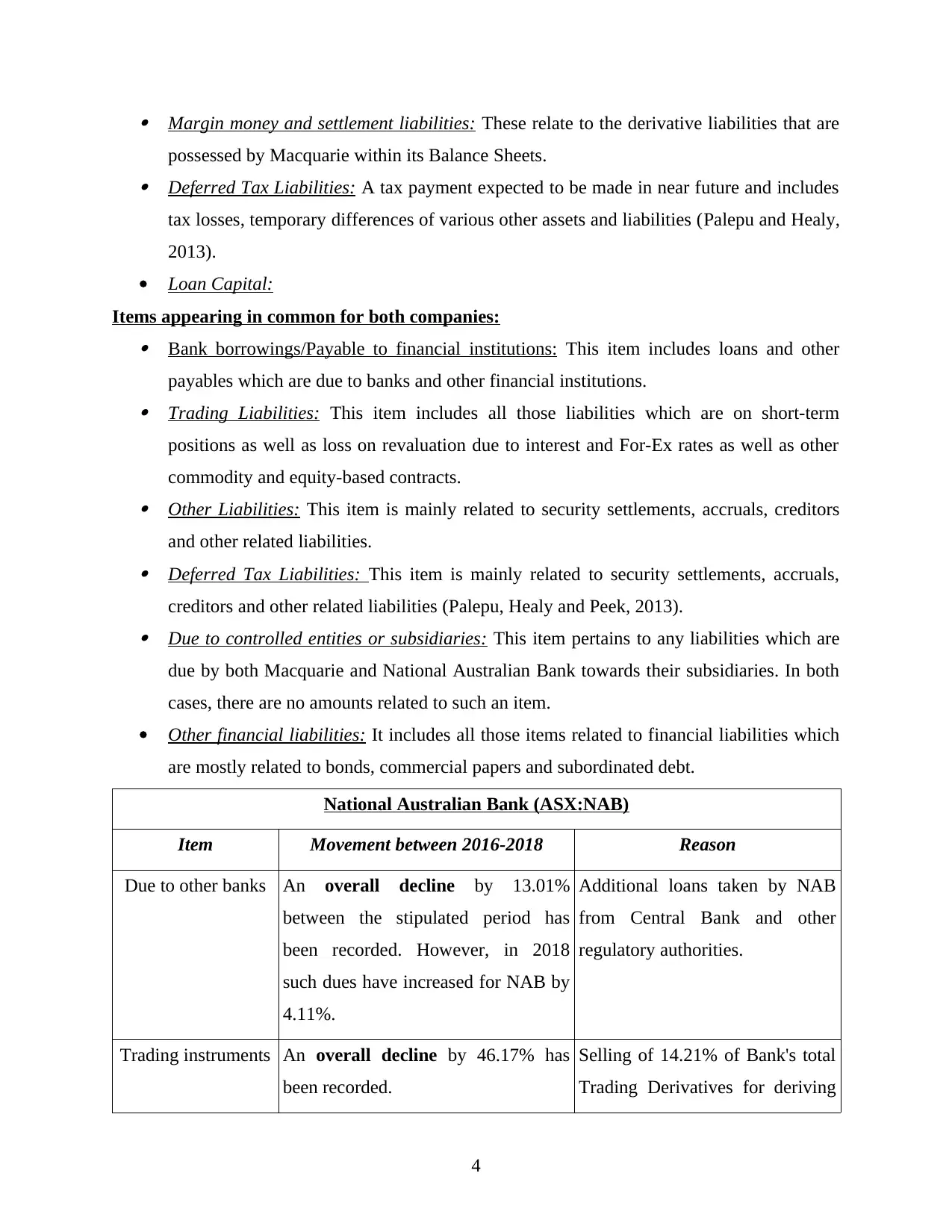
Margin money and settlement liabilities: These relate to the derivative liabilities that are
possessed by Macquarie within its Balance Sheets. Deferred Tax Liabilities: A tax payment expected to be made in near future and includes
tax losses, temporary differences of various other assets and liabilities (Palepu and Healy,
2013).
Loan Capital:
Items appearing in common for both companies: Bank borrowings/Payable to financial institutions: This item includes loans and other
payables which are due to banks and other financial institutions. Trading Liabilities: This item includes all those liabilities which are on short-term
positions as well as loss on revaluation due to interest and For-Ex rates as well as other
commodity and equity-based contracts. Other Liabilities: This item is mainly related to security settlements, accruals, creditors
and other related liabilities. Deferred Tax Liabilities: This item is mainly related to security settlements, accruals,
creditors and other related liabilities (Palepu, Healy and Peek, 2013). Due to controlled entities or subsidiaries: This item pertains to any liabilities which are
due by both Macquarie and National Australian Bank towards their subsidiaries. In both
cases, there are no amounts related to such an item.
Other financial liabilities: It includes all those items related to financial liabilities which
are mostly related to bonds, commercial papers and subordinated debt.
National Australian Bank (ASX:NAB)
Item Movement between 2016-2018 Reason
Due to other banks An overall decline by 13.01%
between the stipulated period has
been recorded. However, in 2018
such dues have increased for NAB by
4.11%.
Additional loans taken by NAB
from Central Bank and other
regulatory authorities.
Trading instruments An overall decline by 46.17% has
been recorded.
Selling of 14.21% of Bank's total
Trading Derivatives for deriving
4
possessed by Macquarie within its Balance Sheets. Deferred Tax Liabilities: A tax payment expected to be made in near future and includes
tax losses, temporary differences of various other assets and liabilities (Palepu and Healy,
2013).
Loan Capital:
Items appearing in common for both companies: Bank borrowings/Payable to financial institutions: This item includes loans and other
payables which are due to banks and other financial institutions. Trading Liabilities: This item includes all those liabilities which are on short-term
positions as well as loss on revaluation due to interest and For-Ex rates as well as other
commodity and equity-based contracts. Other Liabilities: This item is mainly related to security settlements, accruals, creditors
and other related liabilities. Deferred Tax Liabilities: This item is mainly related to security settlements, accruals,
creditors and other related liabilities (Palepu, Healy and Peek, 2013). Due to controlled entities or subsidiaries: This item pertains to any liabilities which are
due by both Macquarie and National Australian Bank towards their subsidiaries. In both
cases, there are no amounts related to such an item.
Other financial liabilities: It includes all those items related to financial liabilities which
are mostly related to bonds, commercial papers and subordinated debt.
National Australian Bank (ASX:NAB)
Item Movement between 2016-2018 Reason
Due to other banks An overall decline by 13.01%
between the stipulated period has
been recorded. However, in 2018
such dues have increased for NAB by
4.11%.
Additional loans taken by NAB
from Central Bank and other
regulatory authorities.
Trading instruments An overall decline by 46.17% has
been recorded.
Selling of 14.21% of Bank's total
Trading Derivatives for deriving
4
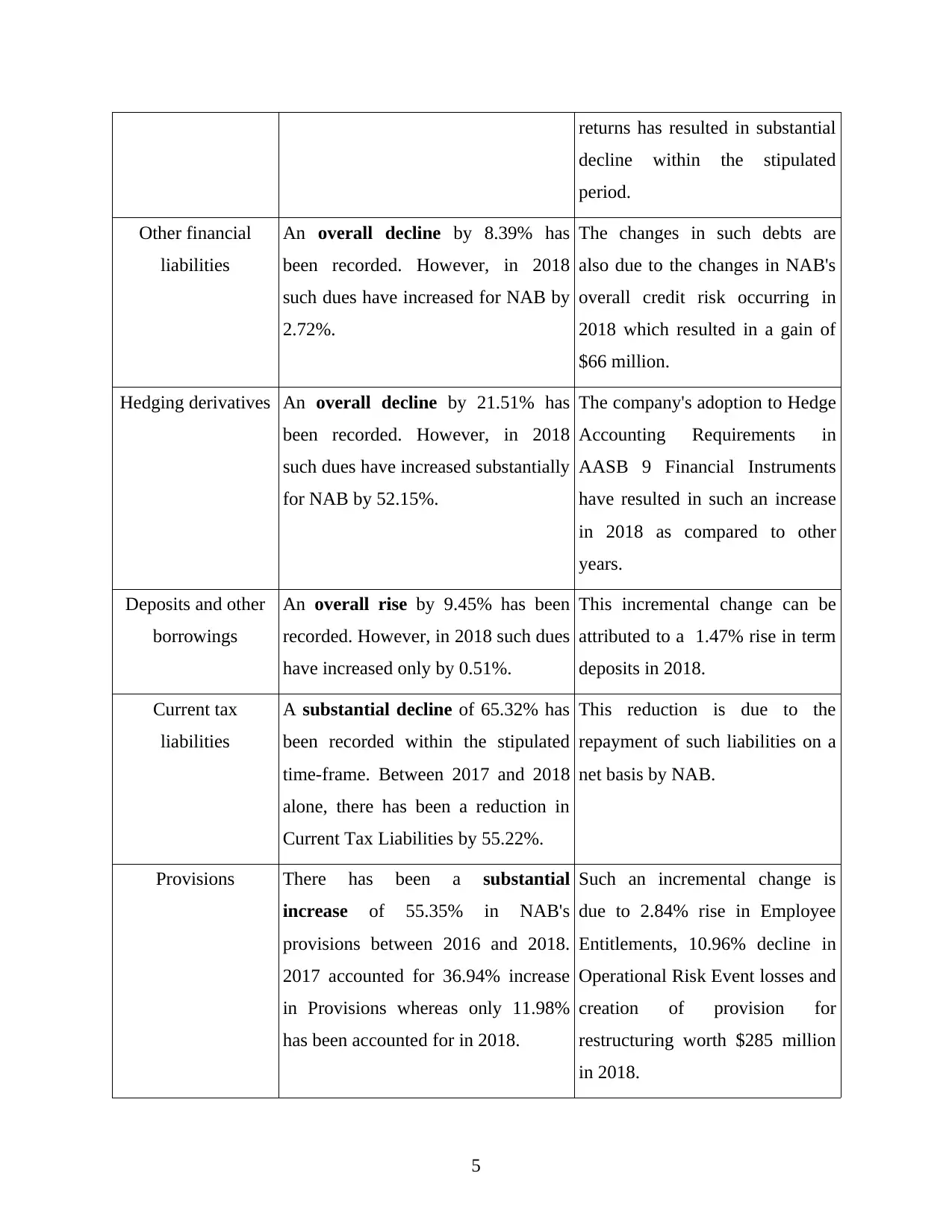
returns has resulted in substantial
decline within the stipulated
period.
Other financial
liabilities
An overall decline by 8.39% has
been recorded. However, in 2018
such dues have increased for NAB by
2.72%.
The changes in such debts are
also due to the changes in NAB's
overall credit risk occurring in
2018 which resulted in a gain of
$66 million.
Hedging derivatives An overall decline by 21.51% has
been recorded. However, in 2018
such dues have increased substantially
for NAB by 52.15%.
The company's adoption to Hedge
Accounting Requirements in
AASB 9 Financial Instruments
have resulted in such an increase
in 2018 as compared to other
years.
Deposits and other
borrowings
An overall rise by 9.45% has been
recorded. However, in 2018 such dues
have increased only by 0.51%.
This incremental change can be
attributed to a 1.47% rise in term
deposits in 2018.
Current tax
liabilities
A substantial decline of 65.32% has
been recorded within the stipulated
time-frame. Between 2017 and 2018
alone, there has been a reduction in
Current Tax Liabilities by 55.22%.
This reduction is due to the
repayment of such liabilities on a
net basis by NAB.
Provisions There has been a substantial
increase of 55.35% in NAB's
provisions between 2016 and 2018.
2017 accounted for 36.94% increase
in Provisions whereas only 11.98%
has been accounted for in 2018.
Such an incremental change is
due to 2.84% rise in Employee
Entitlements, 10.96% decline in
Operational Risk Event losses and
creation of provision for
restructuring worth $285 million
in 2018.
5
decline within the stipulated
period.
Other financial
liabilities
An overall decline by 8.39% has
been recorded. However, in 2018
such dues have increased for NAB by
2.72%.
The changes in such debts are
also due to the changes in NAB's
overall credit risk occurring in
2018 which resulted in a gain of
$66 million.
Hedging derivatives An overall decline by 21.51% has
been recorded. However, in 2018
such dues have increased substantially
for NAB by 52.15%.
The company's adoption to Hedge
Accounting Requirements in
AASB 9 Financial Instruments
have resulted in such an increase
in 2018 as compared to other
years.
Deposits and other
borrowings
An overall rise by 9.45% has been
recorded. However, in 2018 such dues
have increased only by 0.51%.
This incremental change can be
attributed to a 1.47% rise in term
deposits in 2018.
Current tax
liabilities
A substantial decline of 65.32% has
been recorded within the stipulated
time-frame. Between 2017 and 2018
alone, there has been a reduction in
Current Tax Liabilities by 55.22%.
This reduction is due to the
repayment of such liabilities on a
net basis by NAB.
Provisions There has been a substantial
increase of 55.35% in NAB's
provisions between 2016 and 2018.
2017 accounted for 36.94% increase
in Provisions whereas only 11.98%
has been accounted for in 2018.
Such an incremental change is
due to 2.84% rise in Employee
Entitlements, 10.96% decline in
Operational Risk Event losses and
creation of provision for
restructuring worth $285 million
in 2018.
5
⊘ This is a preview!⊘
Do you want full access?
Subscribe today to unlock all pages.

Trusted by 1+ million students worldwide
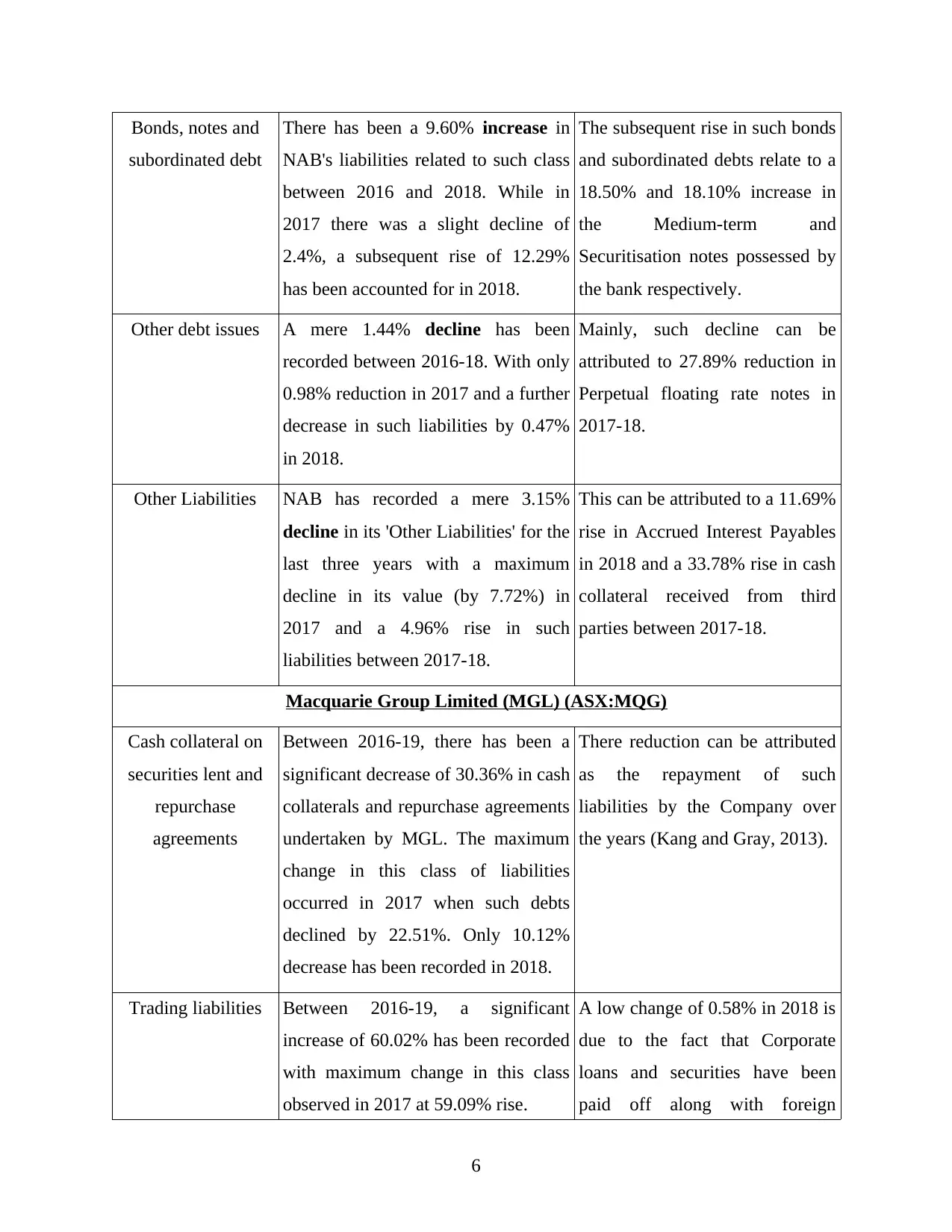
Bonds, notes and
subordinated debt
There has been a 9.60% increase in
NAB's liabilities related to such class
between 2016 and 2018. While in
2017 there was a slight decline of
2.4%, a subsequent rise of 12.29%
has been accounted for in 2018.
The subsequent rise in such bonds
and subordinated debts relate to a
18.50% and 18.10% increase in
the Medium-term and
Securitisation notes possessed by
the bank respectively.
Other debt issues A mere 1.44% decline has been
recorded between 2016-18. With only
0.98% reduction in 2017 and a further
decrease in such liabilities by 0.47%
in 2018.
Mainly, such decline can be
attributed to 27.89% reduction in
Perpetual floating rate notes in
2017-18.
Other Liabilities NAB has recorded a mere 3.15%
decline in its 'Other Liabilities' for the
last three years with a maximum
decline in its value (by 7.72%) in
2017 and a 4.96% rise in such
liabilities between 2017-18.
This can be attributed to a 11.69%
rise in Accrued Interest Payables
in 2018 and a 33.78% rise in cash
collateral received from third
parties between 2017-18.
Macquarie Group Limited (MGL) (ASX:MQG)
Cash collateral on
securities lent and
repurchase
agreements
Between 2016-19, there has been a
significant decrease of 30.36% in cash
collaterals and repurchase agreements
undertaken by MGL. The maximum
change in this class of liabilities
occurred in 2017 when such debts
declined by 22.51%. Only 10.12%
decrease has been recorded in 2018.
There reduction can be attributed
as the repayment of such
liabilities by the Company over
the years (Kang and Gray, 2013).
Trading liabilities Between 2016-19, a significant
increase of 60.02% has been recorded
with maximum change in this class
observed in 2017 at 59.09% rise.
A low change of 0.58% in 2018 is
due to the fact that Corporate
loans and securities have been
paid off along with foreign
6
subordinated debt
There has been a 9.60% increase in
NAB's liabilities related to such class
between 2016 and 2018. While in
2017 there was a slight decline of
2.4%, a subsequent rise of 12.29%
has been accounted for in 2018.
The subsequent rise in such bonds
and subordinated debts relate to a
18.50% and 18.10% increase in
the Medium-term and
Securitisation notes possessed by
the bank respectively.
Other debt issues A mere 1.44% decline has been
recorded between 2016-18. With only
0.98% reduction in 2017 and a further
decrease in such liabilities by 0.47%
in 2018.
Mainly, such decline can be
attributed to 27.89% reduction in
Perpetual floating rate notes in
2017-18.
Other Liabilities NAB has recorded a mere 3.15%
decline in its 'Other Liabilities' for the
last three years with a maximum
decline in its value (by 7.72%) in
2017 and a 4.96% rise in such
liabilities between 2017-18.
This can be attributed to a 11.69%
rise in Accrued Interest Payables
in 2018 and a 33.78% rise in cash
collateral received from third
parties between 2017-18.
Macquarie Group Limited (MGL) (ASX:MQG)
Cash collateral on
securities lent and
repurchase
agreements
Between 2016-19, there has been a
significant decrease of 30.36% in cash
collaterals and repurchase agreements
undertaken by MGL. The maximum
change in this class of liabilities
occurred in 2017 when such debts
declined by 22.51%. Only 10.12%
decrease has been recorded in 2018.
There reduction can be attributed
as the repayment of such
liabilities by the Company over
the years (Kang and Gray, 2013).
Trading liabilities Between 2016-19, a significant
increase of 60.02% has been recorded
with maximum change in this class
observed in 2017 at 59.09% rise.
A low change of 0.58% in 2018 is
due to the fact that Corporate
loans and securities have been
paid off along with foreign
6
Paraphrase This Document
Need a fresh take? Get an instant paraphrase of this document with our AI Paraphraser
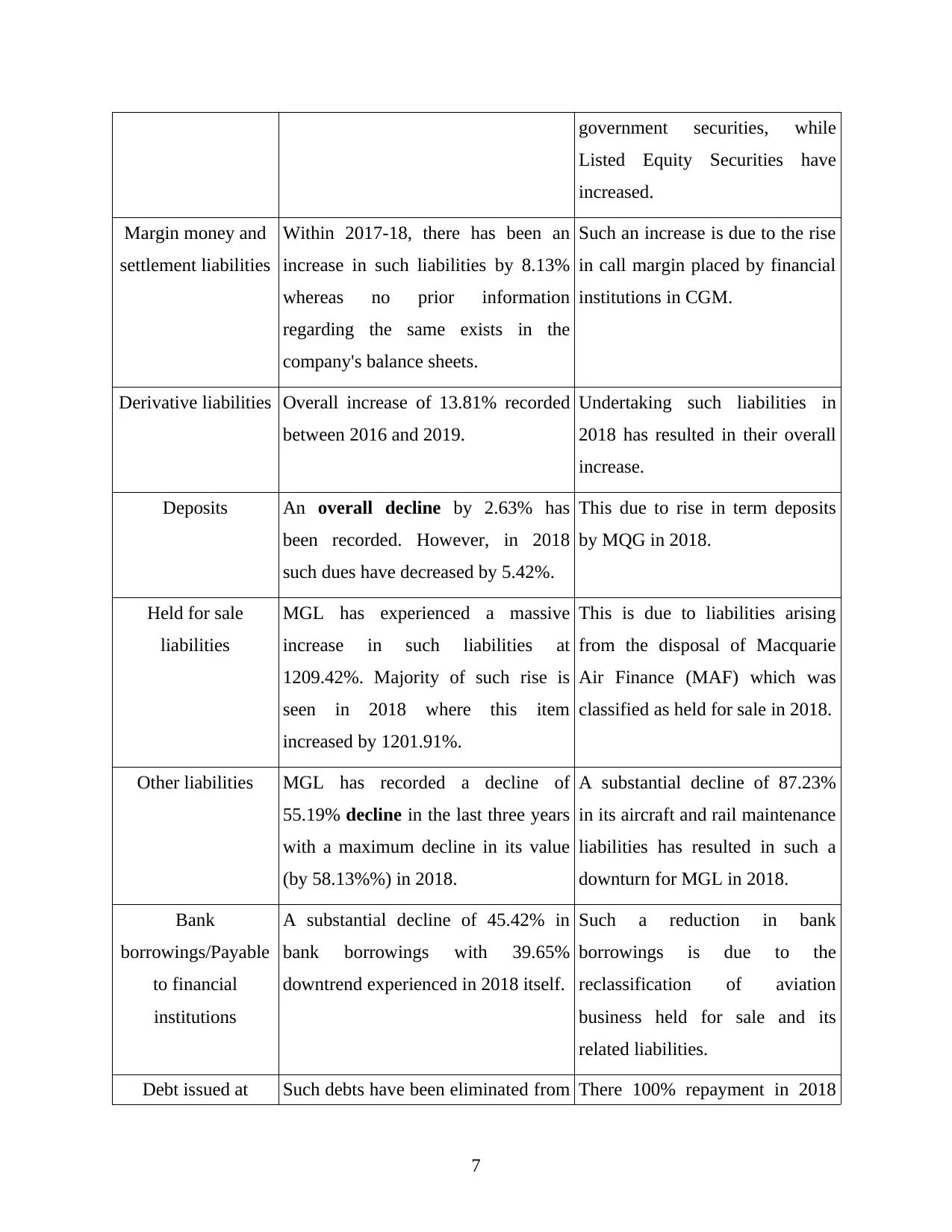
government securities, while
Listed Equity Securities have
increased.
Margin money and
settlement liabilities
Within 2017-18, there has been an
increase in such liabilities by 8.13%
whereas no prior information
regarding the same exists in the
company's balance sheets.
Such an increase is due to the rise
in call margin placed by financial
institutions in CGM.
Derivative liabilities Overall increase of 13.81% recorded
between 2016 and 2019.
Undertaking such liabilities in
2018 has resulted in their overall
increase.
Deposits An overall decline by 2.63% has
been recorded. However, in 2018
such dues have decreased by 5.42%.
This due to rise in term deposits
by MQG in 2018.
Held for sale
liabilities
MGL has experienced a massive
increase in such liabilities at
1209.42%. Majority of such rise is
seen in 2018 where this item
increased by 1201.91%.
This is due to liabilities arising
from the disposal of Macquarie
Air Finance (MAF) which was
classified as held for sale in 2018.
Other liabilities MGL has recorded a decline of
55.19% decline in the last three years
with a maximum decline in its value
(by 58.13%%) in 2018.
A substantial decline of 87.23%
in its aircraft and rail maintenance
liabilities has resulted in such a
downturn for MGL in 2018.
Bank
borrowings/Payable
to financial
institutions
A substantial decline of 45.42% in
bank borrowings with 39.65%
downtrend experienced in 2018 itself.
Such a reduction in bank
borrowings is due to the
reclassification of aviation
business held for sale and its
related liabilities.
Debt issued at Such debts have been eliminated from There 100% repayment in 2018
7
Listed Equity Securities have
increased.
Margin money and
settlement liabilities
Within 2017-18, there has been an
increase in such liabilities by 8.13%
whereas no prior information
regarding the same exists in the
company's balance sheets.
Such an increase is due to the rise
in call margin placed by financial
institutions in CGM.
Derivative liabilities Overall increase of 13.81% recorded
between 2016 and 2019.
Undertaking such liabilities in
2018 has resulted in their overall
increase.
Deposits An overall decline by 2.63% has
been recorded. However, in 2018
such dues have decreased by 5.42%.
This due to rise in term deposits
by MQG in 2018.
Held for sale
liabilities
MGL has experienced a massive
increase in such liabilities at
1209.42%. Majority of such rise is
seen in 2018 where this item
increased by 1201.91%.
This is due to liabilities arising
from the disposal of Macquarie
Air Finance (MAF) which was
classified as held for sale in 2018.
Other liabilities MGL has recorded a decline of
55.19% decline in the last three years
with a maximum decline in its value
(by 58.13%%) in 2018.
A substantial decline of 87.23%
in its aircraft and rail maintenance
liabilities has resulted in such a
downturn for MGL in 2018.
Bank
borrowings/Payable
to financial
institutions
A substantial decline of 45.42% in
bank borrowings with 39.65%
downtrend experienced in 2018 itself.
Such a reduction in bank
borrowings is due to the
reclassification of aviation
business held for sale and its
related liabilities.
Debt issued at Such debts have been eliminated from There 100% repayment in 2018
7
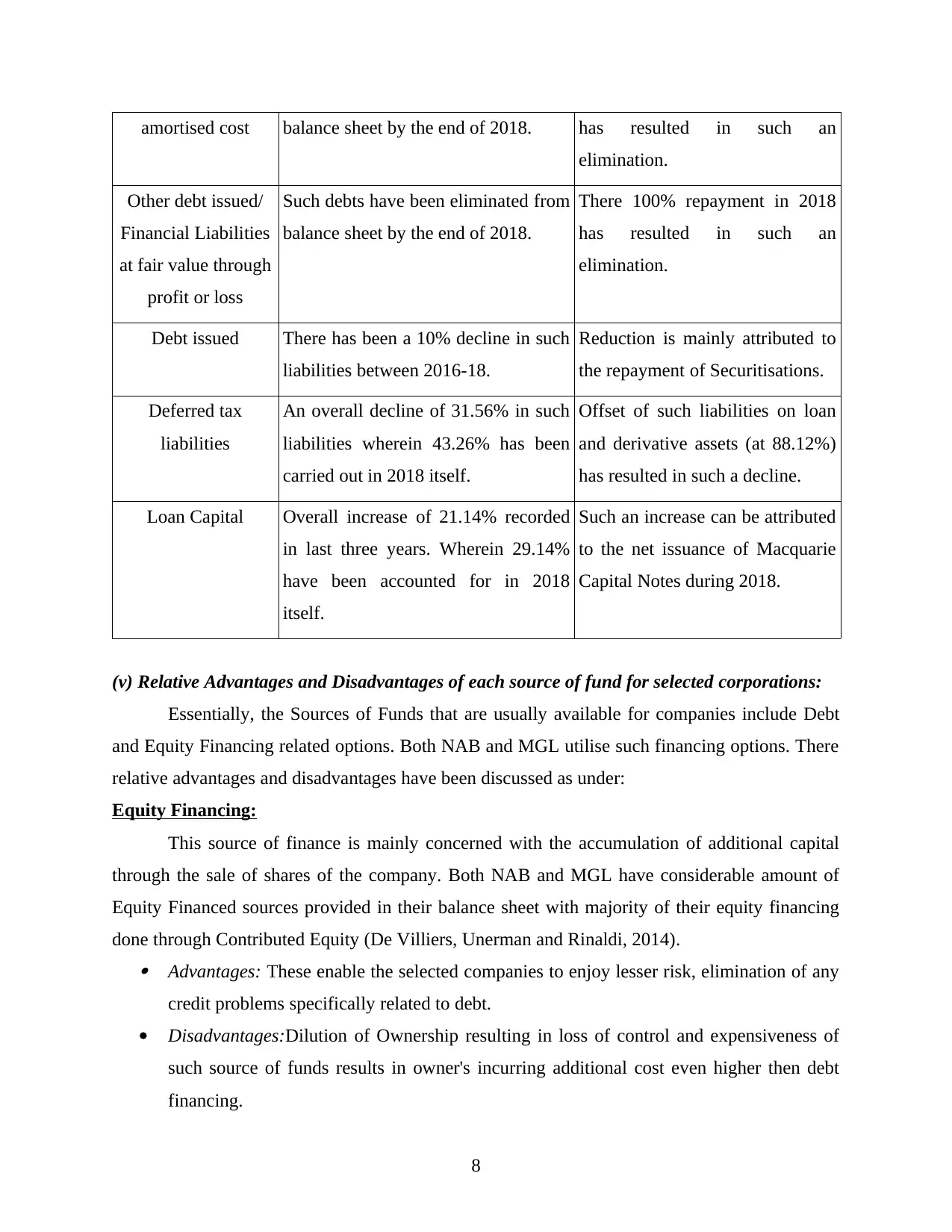
amortised cost balance sheet by the end of 2018. has resulted in such an
elimination.
Other debt issued/
Financial Liabilities
at fair value through
profit or loss
Such debts have been eliminated from
balance sheet by the end of 2018.
There 100% repayment in 2018
has resulted in such an
elimination.
Debt issued There has been a 10% decline in such
liabilities between 2016-18.
Reduction is mainly attributed to
the repayment of Securitisations.
Deferred tax
liabilities
An overall decline of 31.56% in such
liabilities wherein 43.26% has been
carried out in 2018 itself.
Offset of such liabilities on loan
and derivative assets (at 88.12%)
has resulted in such a decline.
Loan Capital Overall increase of 21.14% recorded
in last three years. Wherein 29.14%
have been accounted for in 2018
itself.
Such an increase can be attributed
to the net issuance of Macquarie
Capital Notes during 2018.
(v) Relative Advantages and Disadvantages of each source of fund for selected corporations:
Essentially, the Sources of Funds that are usually available for companies include Debt
and Equity Financing related options. Both NAB and MGL utilise such financing options. There
relative advantages and disadvantages have been discussed as under:
Equity Financing:
This source of finance is mainly concerned with the accumulation of additional capital
through the sale of shares of the company. Both NAB and MGL have considerable amount of
Equity Financed sources provided in their balance sheet with majority of their equity financing
done through Contributed Equity (De Villiers, Unerman and Rinaldi, 2014). Advantages: These enable the selected companies to enjoy lesser risk, elimination of any
credit problems specifically related to debt.
Disadvantages:Dilution of Ownership resulting in loss of control and expensiveness of
such source of funds results in owner's incurring additional cost even higher then debt
financing.
8
elimination.
Other debt issued/
Financial Liabilities
at fair value through
profit or loss
Such debts have been eliminated from
balance sheet by the end of 2018.
There 100% repayment in 2018
has resulted in such an
elimination.
Debt issued There has been a 10% decline in such
liabilities between 2016-18.
Reduction is mainly attributed to
the repayment of Securitisations.
Deferred tax
liabilities
An overall decline of 31.56% in such
liabilities wherein 43.26% has been
carried out in 2018 itself.
Offset of such liabilities on loan
and derivative assets (at 88.12%)
has resulted in such a decline.
Loan Capital Overall increase of 21.14% recorded
in last three years. Wherein 29.14%
have been accounted for in 2018
itself.
Such an increase can be attributed
to the net issuance of Macquarie
Capital Notes during 2018.
(v) Relative Advantages and Disadvantages of each source of fund for selected corporations:
Essentially, the Sources of Funds that are usually available for companies include Debt
and Equity Financing related options. Both NAB and MGL utilise such financing options. There
relative advantages and disadvantages have been discussed as under:
Equity Financing:
This source of finance is mainly concerned with the accumulation of additional capital
through the sale of shares of the company. Both NAB and MGL have considerable amount of
Equity Financed sources provided in their balance sheet with majority of their equity financing
done through Contributed Equity (De Villiers, Unerman and Rinaldi, 2014). Advantages: These enable the selected companies to enjoy lesser risk, elimination of any
credit problems specifically related to debt.
Disadvantages:Dilution of Ownership resulting in loss of control and expensiveness of
such source of funds results in owner's incurring additional cost even higher then debt
financing.
8
⊘ This is a preview!⊘
Do you want full access?
Subscribe today to unlock all pages.

Trusted by 1+ million students worldwide
1 out of 18
Related Documents
Your All-in-One AI-Powered Toolkit for Academic Success.
+13062052269
info@desklib.com
Available 24*7 on WhatsApp / Email
![[object Object]](/_next/static/media/star-bottom.7253800d.svg)
Unlock your academic potential
Copyright © 2020–2025 A2Z Services. All Rights Reserved. Developed and managed by ZUCOL.





